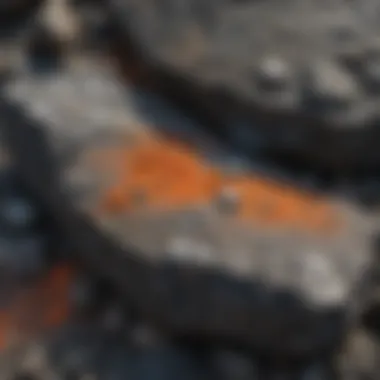Exploring Igneous Rocks: Key Examples and Insights


Intro
Igneous rocks form from the cooling and solidification of magma or lava. Understanding these rocks is crucial for geologists and collectors alike. This article examines the formation processes, classifications, and notable characteristics, presenting examples of igneous rocks and their significance in geology.
Rock and Fossil Identification
When studying igneous rocks, identification is an essential skill. Knowledge of different rock types and their characteristics identifies specimens accurately.
Types of Rocks and Fossils
Igneous rocks are categorized mainly into two types: intrusive and extrusive. Intrusive rocks, like granite, form below the Earth’s surface when magma cools slowly. In contrast, extrusive rocks, such as basalt, result from magma that cools quickly on the surface.
Characteristics to Look For
When identifying igneous rocks, certain features can help distinguish them:
- Texture: Coarse-grained textures indicate slow cooling (intrusive), while fine-grained textures suggest rapid cooling (extrusive).
- Color: The mineral composition gives clues about the rock. For example, lighter colors often indicate higher silica content.
- Mineral Content: Identifying minerals helps clarify the rock's origin. Quartz and feldspar are common in granitic rocks, whereas olivine is often found in basalts.
Tools for Identification
Using the right tools enhances identification:
- Hand Lens: Helps examine mineral details closely.
- Scratch Test Kit: Allows determination of hardness.
- Field Guides: Provides comprehensive information on rock types and characteristics.
Geological Insights
Exploring the geological significance of igneous rocks reveals much about Earth’s history. They represent ancient volcanic activity and play a fundamental role in understanding the planet's evolution.
Geological Formations and Processes
Igneous rocks form through two primary processes: crystallization of magma and cooling of lava. This crystallization process can vary, leading to diverse rock types and textures.
Historical Significance of Rocks and Fossils
Igneous rocks serve as indicators of past geological events like volcanic eruptions. Studying these rocks aids in reconstructing Earth's history.
Notable Discoveries in the Field
Several significant discoveries, such as the study of large igneous provinces, highlight igneous rocks' role in understanding geological phenomena. The Deccan Traps in India are a prime example, showcasing extensive volcanic activity.
"Understanding igneous rocks is not just about collecting; it's about connecting with Earth's history and geological processes."
End
In summary, igneous rocks provide a window into geological processes and history. Their identification and study enrich our understanding of the Earth. Collectors and geologists alike benefit from delving deeper into this fascinating subject.
Prolusion to Igneous Rocks
Igneous rocks hold a crucial place in the study of geology. They offer insights into the Earth's composition and the processes that shape our planet. Understanding igneous rocks is essential for geologists, rock and fossil collectors, and anyone interested in geological sciences. This group of rocks is formed from the cooling and solidification of molten rock, or magma, either beneath the surface or as a result of volcanic eruptions.
The formation processes of igneous rocks reveal important information about the Earth's history and ongoing geological activities. By examining these rocks, one can gain insights into the conditions under which they formed, ranging from ancient volcanic eruptions to the slow crystallization processes that occur deep within the Earth. This knowledge is not only academically significant but also practical for various applications in industries such as construction and architecture.
In this section, we explore two fundamental aspects: the definition and formation of igneous rocks, and their role within the larger geological context, emphasizing their place in the rock cycle. Each of these elements contributes to a richer understanding of igneous rocks, paving the way for deeper exploration in subsequent sections.
Definition and Formation
Igneous rocks are categorized based on their origin, which can either be intrusive or extrusive. Intrusive igneous rocks, such as granite, form when magma cools slowly beneath the Earth’s surface. This slow cooling allows large crystals to develop, leading to coarse-grained textures. On the other hand, extrusive igneous rocks, like basalt, result from lava that cools quickly on the Earth's surface following a volcanic eruption. The rapid cooling produces smaller crystals, often resulting in fine-grained textures.
The study of these definitions is essential in understanding the link between the Earth's internal processes and surface features. As we delve into the intricacies of igneous rock formation, we see how variations in temperature, pressure, and chemical composition contribute to the diverse range of igneous rock types found in nature.


The Rock Cycle Overview
The rock cycle is a fundamental concept in geology explaining the continuous transformation of rocks through various processes. Igneous rocks play a central role in this cycle. As volcanic activity occurs, magma rises and escapes to the surface, becoming lava that solidifies into igneous rock. Over time, these rocks can be weathered and eroded, integrating into sedimentary processes.
Conversely, igneous rocks can also undergo metamorphism. Factors such as high temperature and pressure may transform them into metamorphic rocks. This cycle illustrates not just the dynamic nature of igneous rocks but their connection to other rock types within the Earth’s crust. Understanding these relationships enhances our appreciation of geological time and earth processes.
"The cycle of rock transformation is a remarkable demonstration of nature’s constant change and the interconnectedness of geological processes."
This basic overview lays the groundwork for a deeper analysis of igneous rocks in the sections to follow, where we will look into their classification, examples, and the significance in geological sciences.
Classification of Igneous Rocks
Understanding the classification of igneous rocks is fundamental in the study of geology. Classifying these rocks helps geologists and collectors to communicate about specific types and their characteristics. This classification sheds light on the rocks' formation processes, where they are located, and how they interact with the surrounding environment. Different classifications also aid in predicting the behaviors of igneous rocks under various geothermal conditions. This section delves into two main classifications: intrusive versus extrusive and textural classifications.
Intrusive vs. Extrusive
Igneous rocks are broadly divided into two categories based on their formation: intrusive rocks and extrusive rocks. Intrusive rocks, also known as plutonic rocks, form when magma cools and solidifies beneath the Earth’s surface. Granite is a primary example of an intrusive rock. The slow cooling of magma allows larger crystals to form, leading to a coarse-grained texture.
Extrusive rocks, on the other hand, are formed from lava that cools quickly on the Earth's surface after a volcanic eruption. Basalt serves as a common example of an extrusive rock. The rapid cooling results in smaller crystals and a fine-grained texture.
Both categories reflect different cooling rates and methods of formation, resulting in distinctive physical appearances and mineral compositions. Recognizing these differences is crucial for both amateur collectors and professional geologists. Understanding whether a rock is intrusive or extrusive can provide insights into the geological history of an area. This knowledge influences the types of mineral resources that might be available locally.
Textural Classifications
Textural classification of igneous rocks focuses on the size, shape, and arrangement of the mineral crystals within the rock. This classification can significantly impact the understanding of a rock's formation and behavior. Common textural varieties include:
- Phaneritic: Coarse-grained, means crystallization occurred slowly with larger visible crystals. Examples include granite and diorite.
- Aphanitic: Fine-grained, indicates rapid cooling, making crystal sizes too small to see with the naked eye. Basalt is typical of this texture.
- Porphyritic: Contains larger crystals (phenocrysts) set in a finer-grained matrix. This texture suggests a two-stage cooling process, where magma starts cooling slowly before erupting and cooling rapidly.
- Glassy: No crystals visible, occurring from very rapid cooling, as seen in obsidian.
The textural properties of igneous rocks help collectors and geologists connect the physical characteristics to their geological origins, providing deeper insights into the Earth's history. By observing these textures, enthusiasts can improve their identification skills and gain a better appreciation of the diversity in igneous rock formations.
Key Examples of Igneous Rocks
Understanding key examples of igneous rocks is essential in appreciating their varied roles in geology and practical applications. Each rock type exhibits unique characteristics that can provide insights into geological processes. These examples highlight the diversity of igneous rocks and their significance in both natural and human domains.
Granite
Origin and Formation
Granite is an intrusive igneous rock composed mainly of quartz, feldspar, and mica. It forms from the slow crystallization of magma beneath the Earth's surface. This gradual cooling allows large crystals to develop. Its durability and aesthetic appeal make granite a popular choice for construction. As such, it plays a significant role in architecture and monument-making. The formation of granite also serves as an indicator of continental crust development, providing useful information for geologists.
Uses and Applications
Granite is widely used in construction, particularly in countertops, flooring, and wall cladding. Its resistance to wear and its attractive appearance contribute to its popularity. Additionally, granite is utilized in gravestones, giving it cultural and historical significance. However, the extraction and processing of granite can have ecological impacts, highlighting the need for sustainable practices in quarrying.
Physical Characteristics
The physical characteristics of granite include its coarse-grained texture and range of colors, often including shades of gray, pink, or white. This variation is due to the different minerals present. Granite's strength and abrasion resistance make it a preferred material in environments subjected to heavy use. Its color diversity also enhances its architectural appeal. However, its weight can pose challenges during transportation and installation.
Basalt
Formation Process
Basalt is an extrusive igneous rock formed from the rapid cooling of lava that reaches the surface. This rapid cooling results in small crystals, giving basalt a fine-grained texture. Basalt often forms from volcanic eruptions and covers large areas, such as ocean floors and floodplains. The formation of basalt is crucial in understanding tectonic processes, as it is often associated with divergent plate boundaries. Its widespread occurrence also provides important data for geological mapping.
Cultural Significance
Basalt has significant cultural implications, particularly in art and construction. Many ancient civilizations used basalt for tools, sculptures, and building blocks. Its durability and workability made it an essential resource. In modern times, basalt columns have become a subject of fascination for geologists and tourists alike. However, the cultural appreciation may vary among different regions, reflecting local histories and geologies.
Identification Features


Identifying basalt involves noting its dark color, fine-grained texture, and lack of visible crystals. Common identification features also include its density and specific gravity. Basalt can be classified further by examining its chemical composition. These identification methods are crucial for geologists and collectors, enabling them to classify and study volcanic formations accurately.
Pumice
Properties of Pumice
Pumice is a light, porous volcanic rock resulting from lava that cools rapidly, trapping gas bubbles. This unique property makes pumice less dense than water, allowing it to float. Its abrasiveness enables its use in exfoliating products and construction materials. Pumice's distinct characteristics lend it a valuable place in various industrial applications. Yet, its softness affects its durability in certain contexts.
Common Uses
Pumice is commonly used in beauty products, concrete, and landscaping. Its abrasive texture is valued in cosmetic scrubs, while in construction, it improves the lightweight nature of concrete. Pumice is also utilized for soil conditioning, promoting aeration. However, reliance on pumice resources might necessitate careful management to prevent depletion.
Occurrence
Pumice is often found near active volcanoes or in alluvial deposits. It forms during explosive volcanic eruptions, making its occurrence closely tied to volcanic activity. Understanding where pumice deposits exist aids in predicting volcanic behavior and potential hazards. The geological context of pumice also enriches its collection significance for enthusiasts, showcasing the effects of volcanic processes.
Obsidian
Formation Process
Obsidian is formed from rapidly cooled volcanic lava, resulting in a glassy texture. The lack of crystal structure is what differentiates obsidian from other volcanic rocks. It typically forms in siliceous lava flows where cooling occurs swiftly, often at the Earth’s surface. This quick cooling process has significant implications for the study of igneous rock formation and geological hazards.
Historical Uses
Historically, obsidian was prized for its sharp edges and was used for making tools and weapons. Ancient cultures leveraged its properties for hunting and crafting. Its beauty has also made it a sought-after material for jewelry and ornaments in various civilizations. The historical context of obsidian enhances its value, both as a practical resource and an object of art.
Characteristics
The main characteristic of obsidian is its glassy luster and sharp edges. It typically appears black but can display various colors, including green and brown, depending on impurities present. Its conchoidal fracture makes it ideal for crafting sharp tools. However, its brittleness can limit its use in certain applications. Collectors value obsidian for its unique features, but they should be cautious about how it’s displayed due to its fragility.
Geological Significance of Igneous Rocks
Understanding the geological significance of igneous rocks is essential for grasping their role in Earth's history and structure. These rocks are not just geological formations but also serve as valuable indicators of various geological processes. By studying igneous rocks, we uncover insights about the planet's geothermal activity and tectonic movements. This section delves into how these rocks reveal historical geological events and their significance in current geological studies.
Indicators of Geothermal Activity
Igneous rocks are pivotal in indicating geothermal activity. Their formation is closely tied to the thermal processes occurring within the Earth's mantle and crust. When magma cools either below the surface or after a volcanic eruption, it solidifies to form igneous rocks. This process reflects the conditions of temperature and pressure present at the time of their formation.
Key points regarding geothermal activity include:
- Magma Composition: The chemical and mineral compositions of igneous rocks can indicate the nature of the heat source that produced them. For example, rocks like rhyolite, rich in silica, suggest more evolved magmatic processes.
- Volcanic Activity: The presence of extrusive igneous rocks, such as basalt, is often a sign of ongoing or past volcanic activity. Their distributions can reveal patterns of past tectonic movements and geological activity.
- Hotspots: Regions such as the Hawaiian Islands are formed by hotspots, creating unique igneous rock formations. The study of these rocks helps understand mantle plumes and thermal anomalies in the Earth's lithosphere.
"Studying igneous rocks provides insights not only into past geological processes but also into the ongoing dynamics of our planet."
Role in Plate Tectonics
Igneous rocks play a fundamental role in the theory of plate tectonics, which explains the movement of the Earth's lithospheric plates. Their distribution and types can help identify the tectonic boundaries and the interactions occurring between different plates. Understanding these dynamics is critical for several reasons:
- Subduction Zones: At convergent boundaries, one tectonic plate is forced below another, leading to the melting of the subducted plate. This process often results in the formation of volcanic arcs and associated igneous rocks, such as andesite.
- Divergent Boundaries: At divergent boundaries, tectonic plates move apart, allowing magma to rise from the mantle. The resulting igneous rock formations, like basalt, create new oceanic crust. This activity is instrumental in shaping ocean basins and continental drift.
- Transform Boundaries: Although less common, igneous activity can also occur at transform boundaries, where plates slide past each other. Understanding the associated igneous formations can help assess seismic risks in these regions.
Practical Applications of Igneous Rocks
Igneous rocks are not only important in geological studies but also have numerous practical applications. Their unique properties make them valuable in a variety of fields. Understanding these applications can highlight the rocks' relevance beyond academic interest.
Construction Materials
Igneous rocks such as granite and basalt are frequently used as construction materials. Their strength, durability, and aesthetics make them suitable for various applications. For instance, granite is often used for countertops, flooring, and monuments due to its resistance to wear and ability to retain polish.
Some key attributes of granite as a construction material are:


- High Compressional Strength: This makes it suitable for heavy-load structures.
- Low Porosity: This property prevents the absorption of moisture, making it ideal for outdoor use.
- Variety of Colors and Textures: This enhances aesthetic appeal in building projects.
Basalt, on the other hand, is often found in road construction and as aggregate for concrete. Its dense structure adds substantial strength to building materials. The use of basalt in high-stress environments further exemplifies its importance in engineering applications.
Additionally, gabro, a coarser grained version of basalt, has similar uses in construction due to its durability.
Cultural and Artistic Use
Apart from construction, igneous rocks have been used in cultural and artistic contexts for centuries. Their natural beauty inspires artists, sculptors, and architects alike.
- Sculpture: Artists use granite and basalt for sculptures because of their ability to withstand exposure to the elements. Notable sculptures made from these rocks have become iconic landmarks.
- Decorative Elements: In modern architecture, igneous rocks serve as attractive cladding. Properties such as heat resistance and color variations make them a popular choice.
- Historical Significance: Many ancient civilizations used igneous rocks for monumental architecture, demonstrating their cultural importance. For example, pyramids in Egypt were built using stone blocks, primarily granite.
In essence, igneous rocks bridge the gap between natural resource and human creativity.
The intersection of these two areas emphasizes the diverse applications of igneous rocks. This allows for a better appreciation of their role, not merely as geological specimens but as functional materials in everyday life.
Collecting Igneous Rocks
Collecting igneous rocks is not just a hobby; it is a pathway into understanding the Earth's history and geology. Each specimen provides insight into the processes that shaped our planet. For collectors, this creates both an intellectual and emotional connection to natural history. Collecting these rocks offers multiple benefits, such as scientific learning, appreciation of nature, and the thrill of exploration.
Whether you are a novice or an experienced collector, starting a collection of igneous rocks can be fulfilling. It encourages curiosity about geological formations and the environment. The rocks themselves vary widely in appearance and origin, which adds to the complexity of a collection. The varied textures and colors found in igneous rocks can be fascinating and appeal to aesthetic sensibilities as well.
Collecting igneous rocks also poses certain considerations. Collector should think about the legality of collecting in specific areas. Always check regulations to avoid penalties. Understanding the ethical implications of rock collecting is crucial. Aim to respect natural settings and ecosystems, especially in sensitive areas.
Starting a Collection
Initiating an igneous rock collection begins with education and research. Knowledge about different types of igneous rocks, such as granite, basalt, and pumice, provides a solid foundation. Here are some steps to consider:
- Research Local Geology: Identify local outcrops and formations. Different regions provide unique types of rocks based on their geological settings.
- Set Goals: Determine what you want to collect. Are you interested in specific types, or do you want a diverse range?
- Gather Tools: Collect basic tools like a rock hammer, safety goggles, and a field guide for identification. A sturdy bag will be useful for transporting your finds.
Identifying Genuine Samples
When collecting igneous rocks, being able to identify genuine samples is vital. Counterfeits and altered specimens can find their way into the marketplace. Consider the following tips:
- Physical Characteristics: Study the texture, color, and grain size of rocks. Each type has its unique attributes.
- Associated Minerals: Check for accompanying minerals. Igneous rocks often contain specific minerals that can aid identification.
- Consult Resources: Use books, online databases, or local geological societies as guides for verifying specimens.
Understanding the features of genuine samples enhances the integrity of your collection.
Preservation Techniques
Proper preservation techniques ensure that your collection remains intact and visually appealing. Follow these practices to maintain your rock samples:
- Clean with Care: Use water and a soft brush to clean rocks of dirt. Avoid harsh chemicals that may damage their surface.
- Storage Solutions: Store rocks in a stable environment, protecting them from extremes of temperature and humidity. A dedicated display case or compartmentalized box works well.
- Documentation: Keep detailed records of where each rock was collected, its characteristics, and any significant findings related to its origin. This not only adds value but is a joy to look back on later.
End
The conclusion of this article encapsulates the central themes surrounding igneous rocks, emphasizing their geological significance, diverse forms, and practical applications. Understanding these aspects enhances appreciation for these natural artifacts. Igneous rocks are not just geological specimens; they are a testament to Earth’s complex processes. Their variety serves multiple purposes, both scientific and practical.
Reflection on the Diversity of Igneous Forms
Igneous rocks manifest in a plethora of forms, each with unique characteristics and implications. From granite to basalt, each type provides insight into the conditions under which it formed. The diversity of textures and colors in igneous rocks reflects the various environments they originate from. Collectors may find fascination in this variety, whether they seek aesthetic appeal or scientific relevance.
Key points regarding the diversity include:
- Formation Conditions: Different cooling rates affect crystal sizes and textures.
- Color Variations: The mineral composition determines the visible hue, ranging from light-colored rhyolite to dark basalt.
- Location Specificity: Regional geology influences which igneous rocks are prevalent; volcanic areas often yield a different spectrum than mountain ranges.
Understanding this diversity can enrich a collector's knowledge and enhance fieldwork efficiency, as it may inform where to search for specific rock types.
Future Trends in Igneous Rock Research
Research on igneous rocks is evolving, influenced by advances in technology and changing scientific perspectives. Today, geologists employ sophisticated tools such as remote sensing, geochemical analysis, and numerical modeling. These techniques facilitate deeper understanding of igneous activity and its role in Earth's processes.
Emerging trends include:
- Geothermal Resource Exploration: As energy demands grow, studying igneous formations for geothermal energy extraction becomes increasingly relevant.
- Volcanic Activity Monitoring: Continuous improvement in monitoring volcanic eruptions through real-time data collection ensures better safety measures and understanding of tectonic movements.
- Climate Change Studies: Research linking igneous rock formation with climatic impact can shed light on past environmental changes, helping to predict future trends.
These advancements are shaping a more nuanced appreciation of igneous rocks and their importance not only to geology but also to wider societal endeavors.







